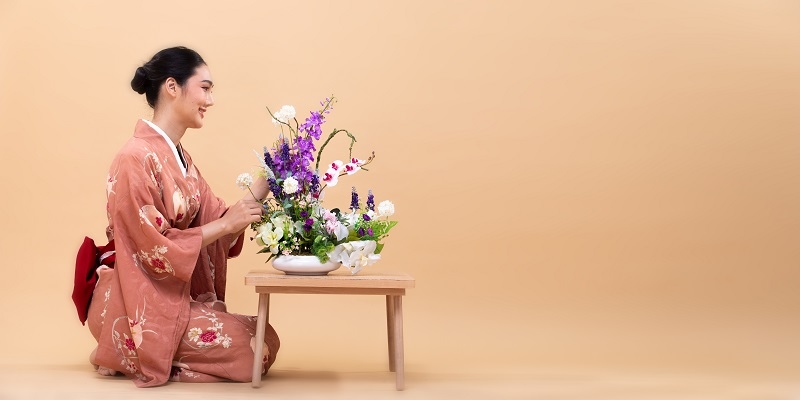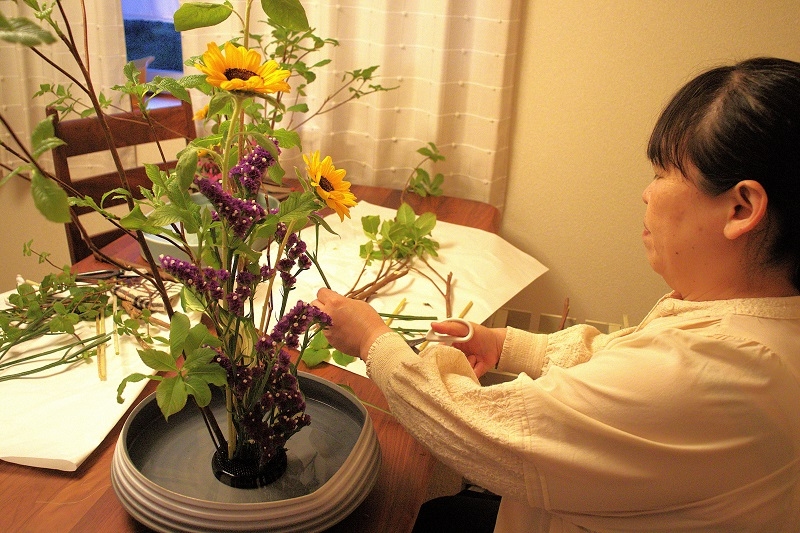
If you’ve ever walked into a Japanese tea house or even glanced at photos of one, you may have noticed something subtle. A single branch placed carefully in a vase. One flower bending toward the light. Nothing crowded. Nothing flashy. And yet it feels powerful. That, in essence, is Ikebana.
Ikebana Japanese flower arrangement is not about filling space but about creating space. It’s as much about what you leave empty as what you include. Western floral design often aims for abundance—a bouquet so full it spills over. Ikebana asks the opposite. What happens when just one stem tells the whole story?
Ikebana didn’t start as home décor. Its roots stretch back to Buddhist rituals, where monks placed flowers at altars. Slowly, that offering became something more structured. By the 15th century, schools of Ikebana had formed in Japan, each with their own ideas about rules and balance.
What makes this art different is how it treats silence and absence as part of the design. A gap is not a flaw. It’s a pause, an exhale.
To outsiders, Ikebana can look simple. A vase, a stem, maybe a branch. But beneath that simplicity lies a philosophy. The three main lines of an arrangement often symbolise heaven, earth, and humanity. The stems aren’t just chosen for looks. They’re placed to represent relationships.
Working on an arrangement slows you down. You notice details you’d normally miss—the tilt of a bud, the way a twig bends. It’s meditative, but it’s also expressive. Every arrangement reflects the hand and mood of the person creating it.
The Ikebana vase isn’t an afterthought. It sets the stage. A shallow dish spreads the arrangement horizontally. A tall vase pulls the eye upward. Some vases are plain, disappearing so the flowers take centre stage. Others are bold, almost sculptural, working with the stems to tell the story.
In Western design, the container often hides behind the flowers. In Ikebana, it’s part of the artwork itself.
There isn’t just one way to practise Ikebana. Traditional schools stick to strict rules about angles and proportions. Modern practitioners take more freedom, sometimes blending Western flowers or unexpected materials.
Yet even experimental Ikebana arrangements feel distinct. They carry a balance that separates them from ordinary bouquets. You can spot it in the quiet tension, the deliberate choices, the sense of harmony between vase, flower, and space.
Materials matter. In Ikebana floral arrangements, the choice of stems is never random. A twisted branch might convey strength. A single open blossom could suggest renewal. Seasonality plays a huge role too. Spring arrangements lean toward cherry blossoms. Autumn might bring chrysanthemums. Winter could feature pine or bamboo.
Even simple garden cuttings can become striking. Stones, moss, or bark often join the composition, reminding us that nature is more than petals.
Every Ikebana flower speaks a language. Chrysanthemums stand for endurance. Plum blossoms whisper of resilience and hope. Lotus flowers often symbolise purity. Selecting and placing them with care turns arrangements into stories, sometimes subtle, sometimes clear.
This is why Ikebana often appears at ceremonies. A single bloom can show respect or remembrance in ways that words may never capture.
Learn More: Japanese Cat Island: A Purrfect 2025 Getaway for Cat Lovers

Today, people practise Ikebana for many reasons. For some, it’s a way to connect with Japanese tradition. For others, it’s a form of mindfulness. Sitting down with stems and focusing on space and balance pulls you out of distraction. It’s one of those rare activities that demands presence.
You don’t need exotic materials to try it. Even a single branch in a thoughtful container can carry meaning. What matters isn’t abundance but attention.
Ikebana’s influence isn’t locked to vases. Its principles show up in architecture, interiors, even graphic design. The use of negative space, the careful lines, the respect for balance—these ideas ripple outward.
Event designers often borrow from Ikebana. A wedding with one bold arrangement in the centre of a room can feel more elegant than a hall bursting with flowers. It’s proof that restraint can be more powerful than excess.
So why has Ikebana lasted when so many trends come and go? Maybe because it answers a human need. In a busy world, it offers stillness. In a noisy culture, it invites silence. In a cluttered life, it celebrates simplicity.
Arranging flowers may seem small, but it gives us a way to reconnect—with nature, with ourselves, with traditions that remind us to pause. That’s a gift that doesn’t age.
For beginners, the advice is simple. Don’t overthink it. Start with one vase, one stem, one moment of quiet. Add a branch. Adjust. Step back and look. Notice the gaps. Notice how space feels as much part of the design as the flowers.
There are schools, workshops, and guides if you want structure. But Ikebana is also about presence. Don’t aim for perfection. Aim for honesty. Your arrangement reflects you, here and now.
One of the quiet joys of Ikebana is how it feels like a dialogue between you and the natural world. You don’t force a branch into place. You study it, turn it in your hands, notice its curve, and then decide how best to honour its shape. Practitioners often say that the materials “tell you” what they want to do. That may sound poetic, but once you try it, you’ll understand.
Unlike cutting flowers to hide flaws, Ikebana accepts imperfections—the knot in the wood, the bend in a stem, the unevenness of a leaf. These quirks are not mistakes. They’re what make the arrangement alive. In that way, Ikebana becomes less about control and more about cooperation.
Also Check Out: Why Kanazawa is Japan's Most Underrated Destination in 2025?
Ikebana is more than decoration. It’s art, philosophy, and mindfulness wrapped into one. With the right Ikebana vase, careful choices in Ikebana floral arrangements, and meaning layered into each Ikebana flower, the practice becomes timeless.
Whether you follow tradition or experiment with modern Ikebana arrangements, the heart of the practice remains the same. It teaches us that beauty doesn’t always mean abundance. Sometimes, one stem placed with care can hold the weight of an entire story.
This content was created by AI